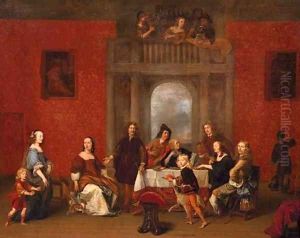Gerrit Pietersz. Van Zijl Paintings
Gerrit Pietersz. van Zijl, also known as Gerrit Pietersz., was a Dutch Golden Age painter born in 1599 in Leiden, Netherlands. Although not as widely recognized as some of his contemporaries, van Zijl was a part of the flourishing artistic movement in the Netherlands during the 17th century, which produced a remarkable number of skilled artists. The Dutch Golden Age was a period of great wealth and cultural achievement for the Dutch Republic, including advances in trade, science, military prowess, and the arts.
Van Zijl's work primarily consisted of genre paintings, which depicted scenes from everyday life. This was a popular subject during the Dutch Golden Age, as the middle-class market for art was expanding and there was an increased interest in paintings that reflected their own lives and environments. Van Zijl's style was influenced by the works of other genre painters of the time, such as Gerrit Dou, who was a student of Rembrandt and known for his finely detailed works.
There is limited information available about van Zijl’s training and early career, but it is assumed that he would have apprenticed under an established artist, as was customary during that time. His paintings often displayed a strong understanding of light and shadow, as well as a keen eye for the textures and details of fabrics and materials, suggesting a refined level of training and skill.
The artist's life was relatively short, as he died in 1650, but his work has been preserved in several collections and continues to be studied by art historians interested in the Dutch Golden Age. Unfortunately, due to the sheer number of artists from this period and the overshadowing fame of figures like Rembrandt, Vermeer, and Frans Hals, van Zijl has not received the same level of lasting recognition. Nonetheless, his contribution to the genre painting of the era adds depth to our understanding of the period’s artistic diversity and the social contexts represented in Dutch art.
The details of van Zijl's personal life, including his training, patrons, and possible influence on other artists, remain somewhat obscure. Nevertheless, his existing works still provide valuable insights into the techniques and themes that were prevalent among Dutch artists of the 17th century. While Gerrit Pietersz. van Zijl may not be a household name, his paintings are a testament to the rich tapestry of talent that existed during one of the most important eras in the history of art.
